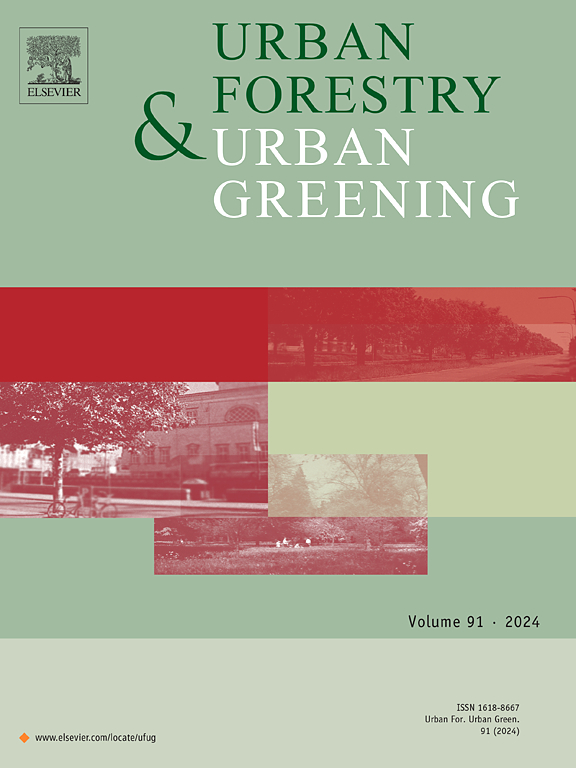Lighting the night: Unveiling the restorative potential of urban green spaces in nighttime environments
IF 6
2区 环境科学与生态学
Q1 ENVIRONMENTAL STUDIES
引用次数: 0
Abstract
The evolution of modern lifestyles has significantly enriched the diversity of nighttime outdoor activities, making the creation of high-quality urban green spaces a significant demand in contemporary living. However, research on the restorative potential of green spaces at night remains scarce, particularly with respect to the restorative benefits of vegetation and lighting characteristics in nocturnal environments. Based on a field experiment conducted in Singapore, known as a Garden City, we assessed visitors’ nighttime restorative experiences in green spaces through self-reported measures. The study focuses on measuring degree of illumination and investigating how nighttime characteristics influence restoration. Our findings reveal that high visual accessibility plays a more positive role in promoting restoration. In addition, path lighting may diminish the experiences of fascination and being away, as does foreground lighting. Restorative effects increase with additional background lighting, closely associated with extent. Enhanced lighting around paths improves evaluations of extent and compatibility, further supporting restoration. Finally, across different lighting directions and distributions, scattered lighting demonstrates greater restorative benefits compared to focused lighting, while uniform light distribution proves critical for visitor experiences. These insights provide valuable guidance for landscape planners and policymakers, enabling them to design restorative nighttime environments through targeted interventions. By integrating social sustainability considerations, nighttime green space lighting design can attract more users, thereby fostering the restorative and health benefits of nocturnal urban environments.
点亮夜晚:揭示夜间环境中城市绿色空间的修复潜力
现代生活方式的演变极大地丰富了夜间户外活动的多样性,创造高质量的城市绿色空间成为当代生活的重要需求。然而,关于夜间绿色空间的恢复潜力的研究仍然很少,特别是关于夜间环境中植被和照明特征的恢复效益。根据在新加坡进行的一项实地实验,我们通过自我报告的方式评估了游客在绿色空间中的夜间恢复体验。研究的重点是测量照明程度和调查夜间特征如何影响恢复。研究结果表明,高视觉可达性对修复具有更积极的促进作用。此外,路径照明可能会减少魅力和离开的体验,前景照明也是如此。随着背景光照的增加,恢复效果会增强,这与程度密切相关。路径周围增强的照明改善了范围和兼容性的评估,进一步支持恢复。最后,在不同的照明方向和分布中,与集中照明相比,分散照明显示出更大的恢复效果,而均匀的光线分布对游客体验至关重要。这些见解为景观规划师和政策制定者提供了有价值的指导,使他们能够通过有针对性的干预来设计恢复性的夜间环境。通过整合社会可持续性的考虑,夜间绿地照明设计可以吸引更多的用户,从而促进夜间城市环境的恢复和健康效益。
本文章由计算机程序翻译,如有差异,请以英文原文为准。
求助全文
约1分钟内获得全文
求助全文
来源期刊

Urban Forestry & Urban Greening
FORESTRY-
CiteScore
11.70
自引率
12.50%
发文量
289
审稿时长
70 days
期刊介绍:
Urban Forestry and Urban Greening is a refereed, international journal aimed at presenting high-quality research with urban and peri-urban woody and non-woody vegetation and its use, planning, design, establishment and management as its main topics. Urban Forestry and Urban Greening concentrates on all tree-dominated (as joint together in the urban forest) as well as other green resources in and around urban areas, such as woodlands, public and private urban parks and gardens, urban nature areas, street tree and square plantations, botanical gardens and cemeteries.
The journal welcomes basic and applied research papers, as well as review papers and short communications. Contributions should focus on one or more of the following aspects:
-Form and functions of urban forests and other vegetation, including aspects of urban ecology.
-Policy-making, planning and design related to urban forests and other vegetation.
-Selection and establishment of tree resources and other vegetation for urban environments.
-Management of urban forests and other vegetation.
Original contributions of a high academic standard are invited from a wide range of disciplines and fields, including forestry, biology, horticulture, arboriculture, landscape ecology, pathology, soil science, hydrology, landscape architecture, landscape planning, urban planning and design, economics, sociology, environmental psychology, public health, and education.
 求助内容:
求助内容: 应助结果提醒方式:
应助结果提醒方式:


